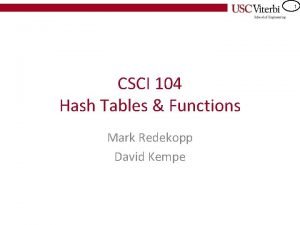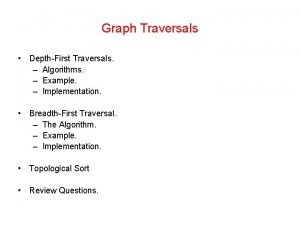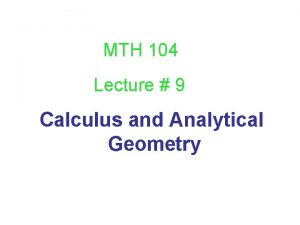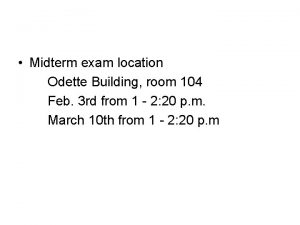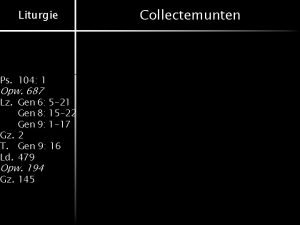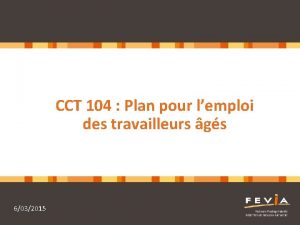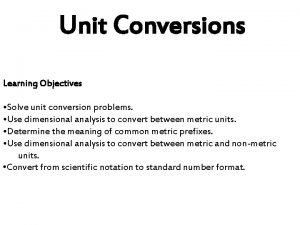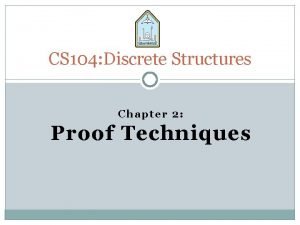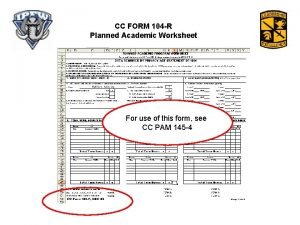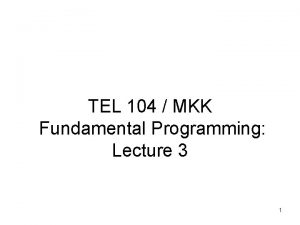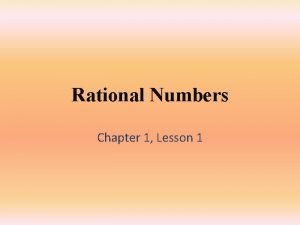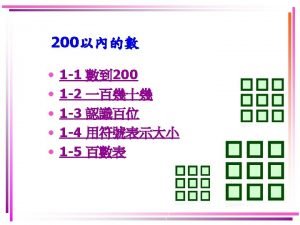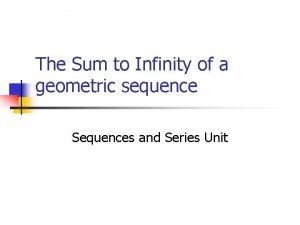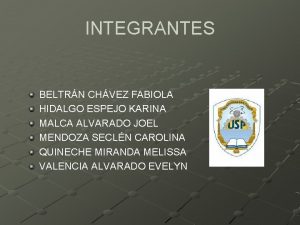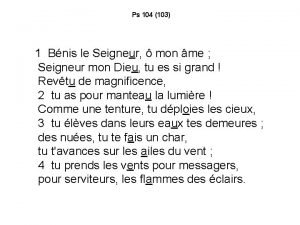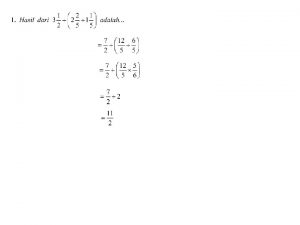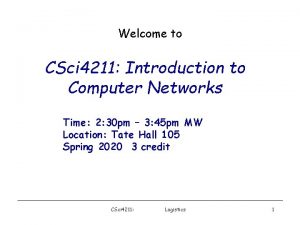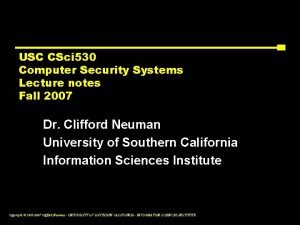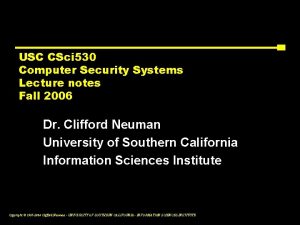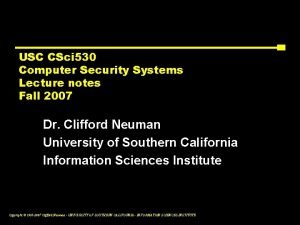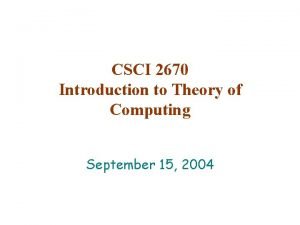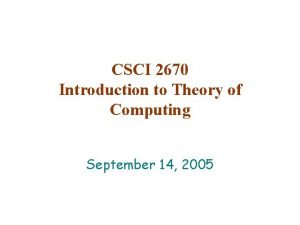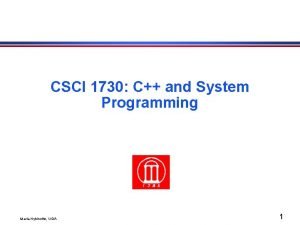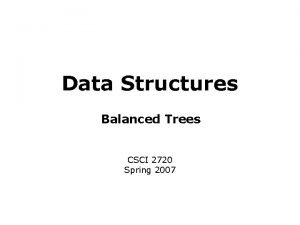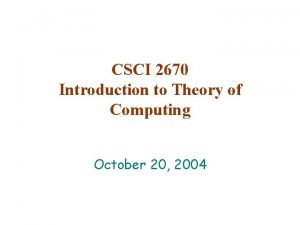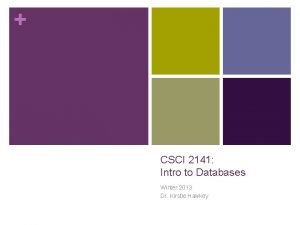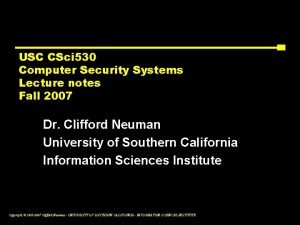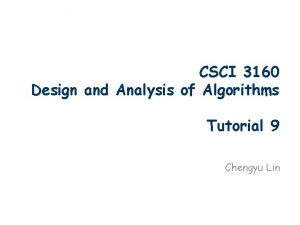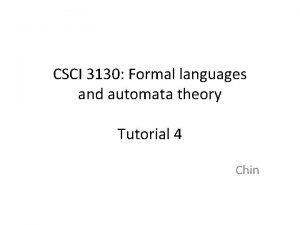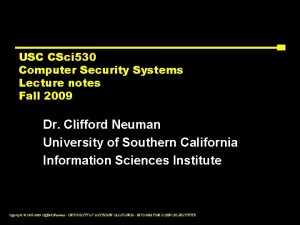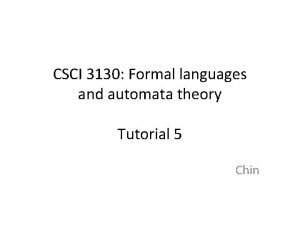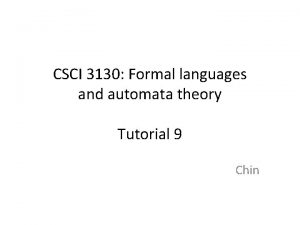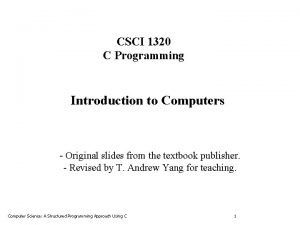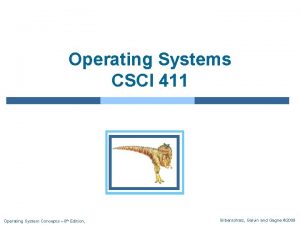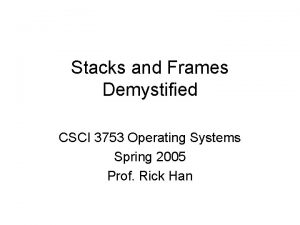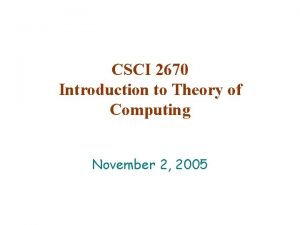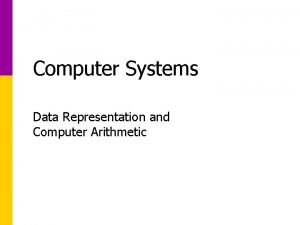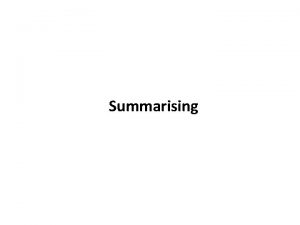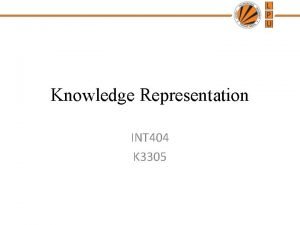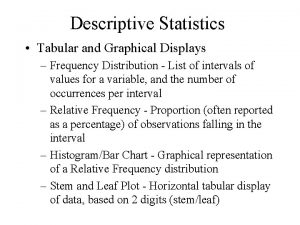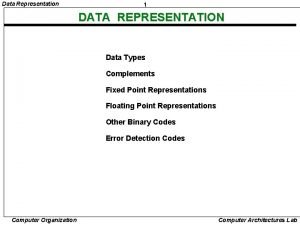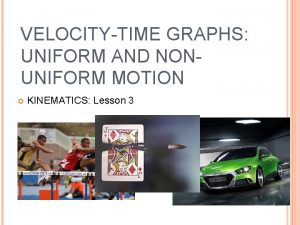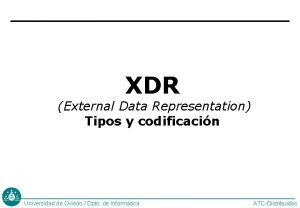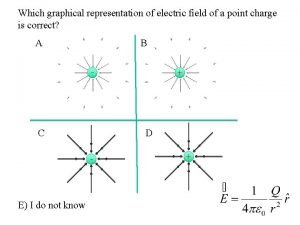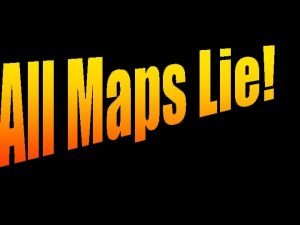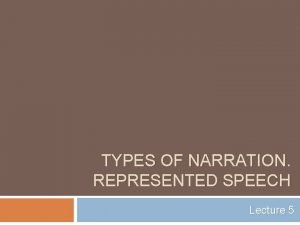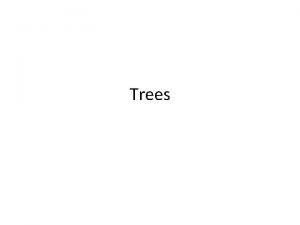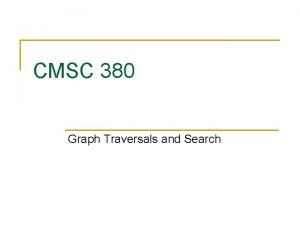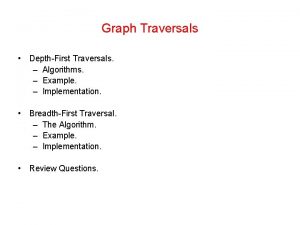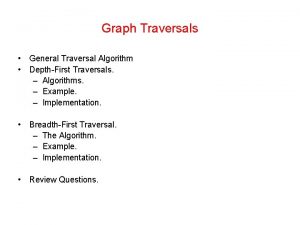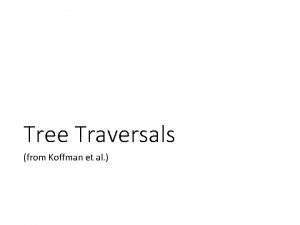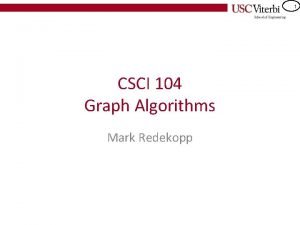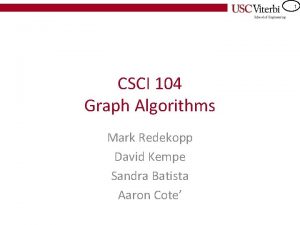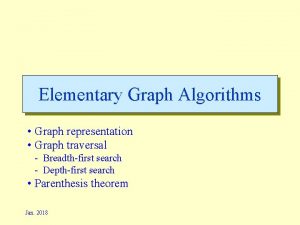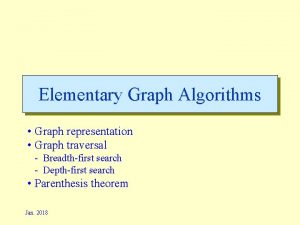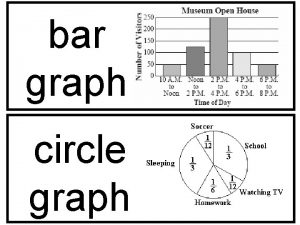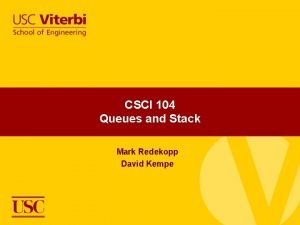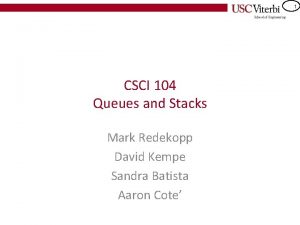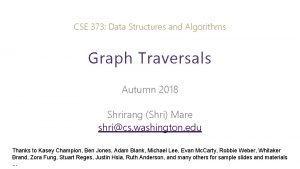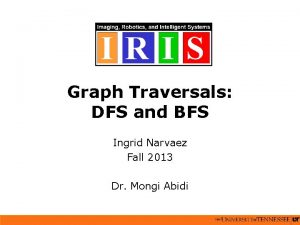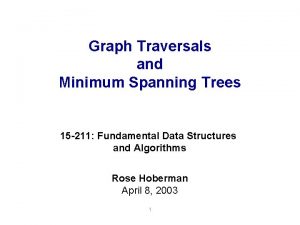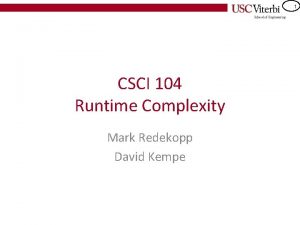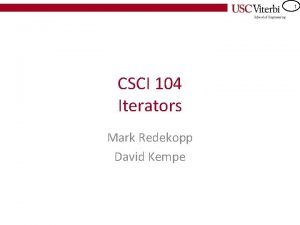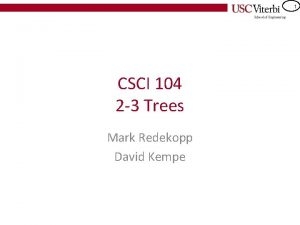1 CSCI 104 Graph Representation and Traversals Mark












































![45 Breadth-First Search Algorithm: BFS(G, u) 1 for each vertex v 2 pred[v] = 45 Breadth-First Search Algorithm: BFS(G, u) 1 for each vertex v 2 pred[v] =](https://slidetodoc.com/presentation_image_h/17f2aab2b33b9072c66f8e8ed3906a40/image-45.jpg)
![46 Breadth-First Search Algorithm: BFS(G, u) 1 for each vertex v 2 pred[v] = 46 Breadth-First Search Algorithm: BFS(G, u) 1 for each vertex v 2 pred[v] =](https://slidetodoc.com/presentation_image_h/17f2aab2b33b9072c66f8e8ed3906a40/image-46.jpg)
![47 Breadth-First Search Algorithm: BFS(G, u) 1 for each vertex v 2 pred[v] = 47 Breadth-First Search Algorithm: BFS(G, u) 1 for each vertex v 2 pred[v] =](https://slidetodoc.com/presentation_image_h/17f2aab2b33b9072c66f8e8ed3906a40/image-47.jpg)








![56 • Define Correctness – dist(s, v) = correct shortest distance – d[v] = 56 • Define Correctness – dist(s, v) = correct shortest distance – d[v] =](https://slidetodoc.com/presentation_image_h/17f2aab2b33b9072c66f8e8ed3906a40/image-56.jpg)
![57 • Define Correctness – dist(s, v) = correct shortest distance – d[v] = 57 • Define Correctness – dist(s, v) = correct shortest distance – d[v] =](https://slidetodoc.com/presentation_image_h/17f2aab2b33b9072c66f8e8ed3906a40/image-57.jpg)




























































- Slides: 117

1 CSCI 104 Graph Representation and Traversals Mark Redekopp David Kempe

2 Origin of Graph Theory • In 1736, Euler solved the problem known as the Seven Bridges of Königsberg. The city of Königsberg, Prussia on the Pregel River, included two large islands connected to each other and the mainland by seven bridges. • The problem is to decide whether it is possible to follow a path that crosses each bridge exactly once (and optionally: returns to the starting point) http: //en. wikipedia. org/wiki/Seven_Bridges_of_K%C 3%B 6 nigsberg

3 Euler’s Analysis • Whenever you enter a non-terminal landmass by a bridge you must leave by another – Because its non-terminal you can't stay once you arrive • Thus every non-terminal landmass must be touching an even number of bridges – So that you can enter on one bridge and leave on another • However, all four of the land masses in the original problem are touched by an odd number of bridges (one is touched by 5 bridges, and each of the other three are touched by 3).

4 Explanation Using Graph Theory • In "graph-speak", Euler showed that the possibility of a walk through a graph, traversing each edge exactly once, depends on the degrees of the nodes. – Euler walk = start/end at different vertices – Euler cycle = start/end at same vertex – The degree of a node is the number of edges touching it. • Euler's argument shows that a necessary condition for the walk of the desired form is that the graph be connected and have exactly zero or two nodes of odd degree. – If there are 2 nodes of odd degree, we can form an Euler walk so that we will start at one of the odd-degree vertices and end at the other • Since the graph corresponding to historical Königsberg has four nodes of odd degree, it cannot have an Eulerian path.

5 GRAPH REPRESENTATIONS

6 Graph Notation • Graphs is a collection of vertices (or nodes) and edges that connect vertices – – Let V be the set of vertices Let E be the set of edges Let |V| or n refer to the number of vertices Let |E| or m refer to the number of edges V a b c d e f g h |V|=n=8 E b |E|=m=11 c a d e (a, c) (a, e) (b, h) (b, c) (c, e) (c, d) (c, g) (d, f) (e, f) (f, g) (g, h) h f g

7 Graphs in the Real World • • • Social networks Computer networks / Internet Path planning Interaction diagrams Bioinformatics

8 Basic Graph Representation • Can simply store edges in list/array – Unsorted – Sorted V a b c d e f g h |V|=n=8 b h c a d E e (a, c) (a, e) (b, h) (b, c) (c, e) (c, d) (c, g) (d, f) (e, f) (f, g) (g, h) |E|=m=11 f g

9 Graph ADT • • What operations would you want to perform on a graph? add. Vertex() : Vertex add. Edge(v 1, v 2) get. Adjacencies(v 1) : List<Vertices> – Returns any vertex with an edge from v 1 to itself • remove. Vertex(v) • remove. Edge(v 1, v 2) • edge. Exists(v 1, v 2) : bool #include<iostream> using namespace std; template <typename V, typename E> class Graph{ }; Perfect for templating the data associated with a vertex and edge as V and E

10 More Common Graph Representations • Graphs are really just a list of lists – List of vertices each having their own list of adjacent vertices d b, g Adjacency Lists List of Vertices – Entry at (i, j) = 1 if there is an edge between vertex i and j, 0 otherwise a b c d e f g h c a • Alternatively, sometimes graphs are also represented with an adjacency matrix c, e c, h a, b, d, e, g c, f a, c, f d, e, g c, f, h h b e g f a b c d e f g h a 0 0 1 0 0 0 b 0 0 1 c 1 1 0 1 0 d 0 0 1 0 0 e 1 0 0 f 0 0 0 1 1 0 g 0 0 1 0 1 h 0 1 0 Adjacency Matrix Representation

11 Graph Representations • Let |V| = n = # of vertices and |E| = m = # of edges • Adjacency List Representation h b c a – O(________) memory storage – Existence of an edge requires searching adjacency list d g • Adjacency Matrix Representation a b c d e f g h c, e c, h a, b, d, e, g c, f a, c, f d, e, g c, f, h b, g Adjacency Lists List of Vertices – O(________) storage – Existence of an edge requires O(_____) lookup e f a b c d e f g h a 0 0 1 0 0 0 b 0 0 1 c 1 1 0 1 0 d 0 0 1 0 0 e 1 0 0 f 0 0 0 1 1 0 g 0 0 1 0 1 h 0 1 0 Adjacency Matrix Representation

12 Graph Representations • Let |V| = n = # of vertices and |E| = m = # of edges • Adjacency List Representation – O(|V| + |E|) memory storage – Existence of an edge requires searching adjacency list – Define degree to be the number of edges incident on a vertex ( deg(a) = 2, deg(c) = 5, etc. d e O(|V|2) storage c, h a, b, d, e, g c, f a, c, f d, e, g c, f, h b, g Adjacency Lists List of Vertices a b c d e f g h c a • Adjacency Matrix Representation – – Existence of an edge requires O(1) lookup (e. g. matrix[i][j] == 1 ) a b h b g f c d e f g h a 0 0 1 0 0 0 b 0 0 1 c 1 1 0 1 0 d 0 0 1 0 0 e 1 0 0 f 0 0 0 1 1 0 g 0 0 1 0 1 h 0 1 0 Adjacency Matrix Representation

13 Graph Representations • Can 'a' get to 'b' in two hops? • Adjacency List h b – For each neighbor of a… – Search that neighbor's list for b c a d g • Adjacency Matrix a b c d e f g h c, e c, h a, b, d, e, g c, f a, c, f d, e, g c, f, h b, g Adjacency Lists List of Vertices – Take the dot product of row a & column b e f a b c d e f g h a 0 0 1 0 0 0 b 0 0 1 c 1 1 0 1 0 d 0 0 1 0 0 e 1 0 0 f 0 0 0 1 1 0 g 0 0 1 0 1 h 0 1 0 Adjacency Matrix Representation

14 Graph Representations • Can 'a' get to 'b' in two hops? • Adjacency List h b – For each neighbor of a… – Search that neighbor's list for b c a d • Adjacency Matrix a b c d e f g h c, e c, h a, b, d, e, g c, f a, c, f d, e, g c, f, h b, g Adjacency Lists List of Vertices – Take the dot product of row a & column b e g f a b c d e f g h a 0 0 1 0 0 0 b 0 0 1 c 1 1 0 1 0 d 0 0 1 0 0 e 1 0 0 f 0 0 0 1 1 0 g 0 0 1 0 1 h 0 1 0 Adjacency Matrix Representation

15 Directed vs. Undirected Graphs • In the previous graphs, edges were undirected (meaning edges are 'bidirectional' or 'reflexive') – An edge (u, v) implies (v, u) • h b c a In directed graphs, links are unidirectional d – An edge (u, v) does not imply (v, u) – For Edge (u, v): the source is u, target is v e f g Source a b c d e f g h c, e h b, d, e, g f f Outgoing Edges List of Vertices • For adjacency list form, you may need 2 lists per vertex for both predecessors and successors g f Target a b c d e f g h a 0 0 1 0 0 0 b 0 0 0 0 1 c 0 1 1 0 d 0 0 0 1 0 0 e 0 0 0 1 0 0 f 0 0 0 0 g 0 0 0 1 0 0 h 0 0 0 1 0 Adjacency Matrix Representation

16 Directed vs. Undirected Graphs • In directed graph with edge (u, v) we define h b – Successor(u) = v – Predecessor(v) = u c a d • Using an adjacency list representation may warrant two lists predecessors and successors e f a b c d e f g h f c a, c d, e, g c, h g b Succs Preds Source List of Vertices Target c, e h b, d, e, g f f g a b c d e f g h a 0 0 1 0 0 0 b 0 0 0 0 1 c 0 1 1 0 d 0 0 0 1 0 0 e 0 0 0 1 0 0 f 0 0 0 0 g 0 0 0 1 0 0 h 0 0 0 1 0 Adjacency Matrix Representation

17 Timeout: Real-world example PAGERANK ALGORITHM

18 Page. Rank • Consider the graph at the right – These could be webpages with links shown in the corresponding direction – These could be neighboring cities • Page. Rank generally tries to answer the question: – If we let a bunch of people randomly "walk" the graph, what is the probability that they end up at a certain location (page, city, etc. ) in the "steady-state" • We could solve this problem through Monte-Carlo simulation (similar to CS 103 Coin-flipping game assignment) – Simulate a large number of random walkers and record where each one ends to build up an answer of the probabilities for each vertex • But there are more efficient ways of doing it a d c b e

19 Page. Rank a • Let us write out the adjacency matrix for this graph • Now let us make a weighted version by normalizing based on the out-degree of each node c b • From this you could write a system of linear equations (i. e. what are the chances you end up at vertex I at the next time step, given you are at some vertex J now e a Source b c d e a 0 1 0 0 0 b 0 0 1 0 0 c 1 0 0 1 1 d 0 0 1 e 0 1 0 0 0 Adjacency Matrix Source=j Target=i p. A = 0. 5*p. B = p. C = p. A + p. D + 0. 5*p. E p. D = 0. 5*p. E = 0. 5*p. B We also know: p. A + p. B + p. C + p. D + p. E = 1 Target – Ex. If you're at node B we have a 50 -50 chance of going to A or E – – – d a b c d e a 0 0. 5 0 0 0 b 0 0 1 0 0 c 1 0 0 1 0. 5 d 0 0 0. 5 e 0 0. 5 0 0 0 Weighted Adjacency Matrix [Divide (ai, j)/degree(j)]

20 • System of Linear Equations – – – Page. Rank a d c p. A = 0. 5*p. B = p. C = p. A + p. D + 0. 5*p. E p. D = 0. 5*p. E = 0. 5*p. B We also know: p. A + p. B + p. C + p. D + p. E = 1 b e Source=j Target=i • If you know something about linear algebra, you know we can write these equations in matrix form as a linear system a b c d e a 0 0. 5 0 0 0 b 0 0 1 0 0 c 1 0 0 1 0. 5 d 0 0 0. 5 e 0 0. 5 0 0 0 Weighted Adjacency Matrix [Divide by (ai, j)/degree(j)] – Ax = y 0 0. 5 0 0 0 p. A = 0. 5 PB 0 0 1 0 0 p. B = p. C 1 0 0 1 0. 5 0 0 0 0 0. 5 p. D = 0. 5*p. E 0 0. 5 0 0 0 p. E = 0. 5*p. B * * p. C = p. A+p. D+0. 5*p. E

21 Page. Rank • But remember we want the steady state solution – The solution where the probabilities don't change from one step to the next • So we want a solution to: Ap = p • We can: a c – Use a linear system solver (Gaussian elimination) – Or we can just seed the problem with some probabilities and then just iterate until the solution settles down 0. 5 0 0 0 p. A 0 0 1 0 0 p. B 1 0 0 1 0. 5 0 0 0. 5 p. D 0 0. 5 0 0 0 p. E * p. C = p. C b e Source=j Target=i 0 d a b c d e a 0 0. 5 0 0 0 b 0 0 1 0 0 c 1 0 0 1 0. 5 d 0 0 0. 5 e 0 0. 5 0 0 0 Weighted Adjacency Matrix [Divide by (ai, j)/degree(j)]

22 • Iterative Page. Rank But remember we want the steady state solution a – The solution where the probabilities don't change from one step to the next • • d c So we want a solution to: Ap = p We can: b e – Use a linear system solver (Gaussian elimination) – Or we can just seed the problem with some probabilities and then just iterate until the solution settles down Step 0 Sol. Step 1 Sol. Step 29 Sol. Step 30 Sol. 0 0. 5 0 0 0 . 2 . 1 0 0. 5 0 0 0 ? 0 0 1 0 0 . 2 . 1507 . 2 0 0 1 0 0 ? 1 0 0 1 0. 5 . 3078 . 5 1 0 0 1 0. 5 0 0 0. 5 . 2 . 1 0 0 0. 5 ? 0 0. 5 0 0 0 . 2 . 0783 . 1 0 0. 5 0 0 0 ? . 1507 * . 2 = Step 1 Sol. 0. 5 0 0 0 . 1 0 0 . 2 . 5 1 0 0 1 0. 5 0 0 0. 5 . 1 . 05 0 0 0 . 1 . 5 ? = Step 2 Sol. 0 * * = . 25 Actual Page. Rank Solution from solving linear system: . 1538. 3077. 0769. 1538 . 3126

23 • Additional Notes a d c b e

24 In a Web Search Setting • • Given some search keywords we could find the pages that have that matching keywords We often expand that set of pages by including all successors and predecessors of those pages – Include all pages that are within a radius of 1 of the pages that actually have the keyword • • Now consider that set of pages and the subgraph that it induces Run Page. Rank on that subgraph Full Web. Graph Page Hits (Contain keyword) Expanded (Preds & Succs) g g g a d a c b a c e f d b d a c e f Induced Subgraph to run Page. Rank b c e f d b e

25 TREES

26 Tree Definitions – Part 1 • Definition: A connected, acyclic (no cycles) graph with: – A root node, r, that has 0 or more subtrees – Exactly one path between any two nodes • • In general: – Nodes have exactly one parent (except for the root which has none) and 0 or more children • d-ary tree – Tree where each node has at most d children – Binary tree = d-ary Tree with n=2 root siblings • • • parent Right child Left child Terms: Ancestor • • A 3 -ary (trinary) tree • Leaf Descendant subtree Parent(i): Node directly above node i Child(i): Node directly below node i Siblings: Children of the same parent Root: Only node with no parent Leaf: Node with 0 children Height: Length of largest path from root to any leaf Subtree(n): Tree rooted at node n Ancestor(n): Any node on the path from n to the root Descendant(n): Any node in the subtree rooted at n

27 Tree Definitions – Part 2 • Tree height: maximum # of nodes on a path from root to any leaf • Full d-ary tree, T, where – Every vertex has 0 or d children and all leaf nodes are at the same level – If height h>1 and both subtrees are full binary trees of height, hnil – If height h==1, then it is full by definition Full Complete, but not full • Complete d-ary tree – Each level is filled left-to-right and a new level is not started until the previous one is complete • Balanced d-ary tree – Tree where subtrees from any node differ in height by at most 1 DAPS, 6 th Ed. Figure 15 -8 Full Complete

28 Tree Height • 15 nodes => height log 2(16) = 4 5 nodes => height = 5

29 Tree Traversals • A traversal iterates over all nodes of the tree – Usually using a depth-first, recursive approach • Three general traversal orderings – Pre-order [Process root then visit subtrees] – In-order [Visit left subtree, process root, visit right subtree] – Post-order [Visit left subtree, visit right subtree, process root] 60 20 80 Preorder(Tree. Node* t) { if t == NULL return process(t) // print val. Preorder(t->left) Preorder(t->right) } 60 20 10 30 25 50 80 10 30 25 50 Postorder(Tree. Node* t) { if t == NULL return Postorder(t->left) Postorder(t->right) process(t) // print val. } 10 25 50 30 20 80 60 Inorder(Tree. Node* t) { if t == NULL return Inorder(t->left) process(t) // print val. Inorder(t->right) } 10 20 25 30 50 60 80

30 Array-based and Link-based TREE IMPLEMENTATIONS

31 Array-Based Complete Binary Tree • Binary tree that is complete (i. e. only the lowest-level contains empty locations and items added left to right) can be stored nicely in an array (let’s say it starts at index 1 and index 0 is empty) • Can you find the mathematical relation for finding the index of node i's parent, left, and right child? – Parent(i) = _____ – Left_child(i) = ______ – Right_child(i) = ______ 7 0 18 9 19 35 14 28 39 36 43 16 17 10 1 2 3 4 5 6 7 8 em 7 18 9 19 35 14 10 28 39 36 43 16 17 parent(5) = _______ Left_child(5) = ____ Right_child(5) = _____ 9 10 11 12 13

32 Array-Based Complete Binary Tree • Binary tree that is complete (i. e. only the lowest-level contains empty locations and items added left to right) can be stored nicely in an array (let’s say it starts at index 1 and index 0 is empty) • Can you find the mathematical relation for finding node i's parent, left, and right child? – Parent(i) = i/2 – Left_child(i) = 2*i – Right_child(i) = 2*i + 1 0 1 2 3 4 5 6 7 8 9 10 11 12 13 em 7 18 9 19 35 14 10 28 39 36 43 16 17 7 18 parent(5) = 5/2 = 2 Left_child(5) = 2*5 = 10 Right_child(5) = 2*5+1 = 11 9 19 35 14 28 39 36 43 16 17 10 Non-complete binary trees require much more bookeeping to store in arrays…usually linkbased approaches are preferred

33 0 -Based Indexing • Binary tree that is complete (i. e. only the lowest-level contains empty locations and items added left to right) can be stored nicely in an array (let’s say it starts at index 1 and index 0 is empty) • Can you find the mathematical relation for finding the index of node i's parent, left, and right child? – Parent(i) = _____ – Left_child(i) = ______ – Right_child(i) = ______ 7 18 9 19 35 14 28 39 36 43 16 17 10 0 1 2 3 4 5 6 7 7 18 9 19 35 14 10 28 39 36 43 16 17 parent(5) = _______ Left_child(5) = ____ Right_child(5) = _____ 8 9 10 11 12

34 D-ary Array-based Implementations • Arrays can be used to store d-ary complete trees – Adjust the formulas derived for binary trees in previous slides in terms of d 7 18 9 19 35 21 26 A 3 -ary (trinary) tree 0 1 2 3 4 5 6 7 18 9 19 35 21 26

35 Link-Based Approaches • Much like a linked list but now with two pointers per Item • Use NULL pointers to indicate no child • Dynamically allocate and free items when you add/remove them #include<iostream> using namespace std; template <typename T> struct BTItem { T val; BTItem<T>* left, right; BTItem<T>* parent; }; // Bin. Search Tree template <typename T> class Bin. Tree { public: Bin. Tree(); ~Bin. Tree(); void add(const T& v); . . . private: BTItem<T>* root_; }; class Linked. BST: 0 x 0 root_ BTItem<T> blueprint: Item<T>* parent Item<T>* T Item<T>* left val right

36 • Add(5) • Add(6) • Add(7) 2 0 x 1 c 0 Left Link-Based Approaches 1 root_ Parent val right 3 class Linked. BST: root_ 0 x 0 root_ 4 root_

37 • Add(5) • Add(6) • Add(7) 2 0 x 1 c 0 Left NULL Link-Based Approaches 0 x 1 c 0 root_ parent NULL val right 5 NULL 1 3 class Linked. BST: 0 x 0 root_ 0 x 1 c 0 root_ parent NULL Left val NULL 5 0 x 1 c 0 parent NULL Left val NULL 5 4 right 0 x 2 a 0 parent 0 x 1 c 0 Left val right NULL 6 NULL 0 x 2 a 0 right 0 x 2 a 0 parent 0 x 1 c 0 Left val right NULL 6 0 x 0 e 0 0 x 2 a 0 parent 0 x 2 a 0 Left val right NULL 7 NULL 0 x 0 e 0

38 BREADTH-FIRST SEARCH

39 Breadth-First Search • Given a graph with vertices, V, and edges, E, and a starting vertex that we'll call u • BFS starts at u (‘a’ in the diagram to the left) and fans-out along the edges to nearest neighbors, then to their neighbors and so on • Goal: Find shortest paths (a. k. a. minimum number of hops or depth) from the start vertex to every other vertex b 0 h c a d e f Depth 0: a g

40 Breadth-First Search • Given a graph with vertices, V, and edges, E, and a starting vertex, u • BFS starts at u (‘a’ in the diagram to the left) and fans-out along the edges to nearest neighbors, then to their neighbors and so on • Goal: Find shortest paths (a. k. a. minimum number of hops or depth) from the start vertex to every other vertex h b 0 1 a c d 1 e f Depth 0: a Depth 1: c, e g

41 Breadth-First Search • Given a graph with vertices, V, and edges, E, and a starting vertex, u • BFS starts at u (‘a’ in the diagram to the left) and fans-out along the edges to nearest neighbors, then to their neighbors and so on • Goal: Find shortest paths (a. k. a. minimum number of hops or depth) from the start vertex to every other vertex 2 h b 0 1 a c 2 d 1 e 2 f Depth 0: a Depth 1: c, e Depth 2: b, d, f, g 2 g

42 Breadth-First Search • Given a graph with vertices, V, and edges, E, and a starting vertex, u • BFS starts at u (‘a’ in the diagram to the left) and fans-out along the edges to nearest neighbors, then to their neighbors and so on • Goal: Find shortest paths (a. k. a. minimum number of hops or depth) from the start vertex to every other vertex 3 2 h b 0 1 a c 2 d 1 e 2 f Depth 0: a Depth 1: c, e Depth 2: b, d, f, g Depth 3: h 2 g

43 Developing the Algorithm • Key idea: Must explore all nearer neighbors before exploring furtheraway neighbors • From ‘a’ we find ‘e’ and ‘c’ – Computer can only do one thing at a time so we have to pick either e or c to explore from – Let’s say we pick e…we will find f – Now what vertex should we explore (i. e. visit neighbors) next? – C!! (if we don’t we won’t find shortest paths…e. g. d) – Must explore all vertices at depth i before any vertices at depth i+1 h b 0 1 a c d 1 e 2 f Depth 0: a Depth 1: c, e Depth 2: b, d, f, g Depth 3: h g

44 Developing the Algorithm • Exploring all vertices in the order they are found implies we will explore all vertices at shallower depth before greater depth – Keep a first-in / first-out queue (FIFO) of neighbors found • Put newly found vertices in the back and pull out a vertex from the front to explore next • We don’t want to put a vertex in the queue more than once… – ‘mark’ a vertex the first time we encounter it – only allow unmarked vertices to be put in the queue • May also keep a ‘predecessor’ structure that indicates how each vertex got discovered (i. e. which vertex caused this one to be found) – Allows us to find a shortest-path back to the start vertex
![45 BreadthFirst Search Algorithm BFSG u 1 for each vertex v 2 predv 45 Breadth-First Search Algorithm: BFS(G, u) 1 for each vertex v 2 pred[v] =](https://slidetodoc.com/presentation_image_h/17f2aab2b33b9072c66f8e8ed3906a40/image-45.jpg)
45 Breadth-First Search Algorithm: BFS(G, u) 1 for each vertex v 2 pred[v] = nil, d[v] = inf. 3 Q = new Queue 4 Q. enqueue(u), d[u]=0 5 while Q is not empty 6 v = Q. front(); Q. dequeue() 7 foreach neighbor, w, of v: 8 if pred[w] < 0 // w not found 9 Q. enqueue(w) 10 pred[w] = v, d[w] = d[v] + 1 nil, inf b nil, 0 h c nil, inf a nil, inf Q: a e d nil, inf f nil, inf g
![46 BreadthFirst Search Algorithm BFSG u 1 for each vertex v 2 predv 46 Breadth-First Search Algorithm: BFS(G, u) 1 for each vertex v 2 pred[v] =](https://slidetodoc.com/presentation_image_h/17f2aab2b33b9072c66f8e8ed3906a40/image-46.jpg)
46 Breadth-First Search Algorithm: BFS(G, u) 1 for each vertex v 2 pred[v] = nil, d[v] = inf. 3 Q = new Queue 4 Q. enqueue(u), d[u]=0 5 while Q is not empty 6 v = Q. front(); Q. dequeue() 7 foreach neighbor, w, of v: 8 if pred[w] < 0 // w not found 9 Q. enqueue(w) 10 pred[w] = v, d[w] = d[v] + 1 nil, inf h b nil, 0 a, 1 a c nil, inf d a, 1 e v= a Q: e c nil, inf f nil, inf g
![47 BreadthFirst Search Algorithm BFSG u 1 for each vertex v 2 predv 47 Breadth-First Search Algorithm: BFS(G, u) 1 for each vertex v 2 pred[v] =](https://slidetodoc.com/presentation_image_h/17f2aab2b33b9072c66f8e8ed3906a40/image-47.jpg)
47 Breadth-First Search Algorithm: BFS(G, u) 1 for each vertex v 2 pred[v] = nil, d[v] = inf. 3 Q = new Queue 4 Q. enqueue(u), d[u]=0 5 while Q is not empty 6 v = Q. front(); Q. dequeue() 7 foreach neighbor, w, of v: 8 if pred[w] < 0 // w not found 9 Q. enqueue(w) 10 pred[w] = v, d[w] = d[v] + 1 nil, inf h b nil, 0 a, 1 a c nil, inf d a, 1 e v= e Q: c f e, 2 f nil, inf g

48 Breadth-First Search Algorithm: nil, inf c, 2 BFS(G, u) 1 for each vertex v 2 pred[v] = nil, d[v] = inf. 3 Q = new Queue 4 Q. enqueue(u), d[u]=0 5 while Q is not empty 6 v = Q. front(); Q. dequeue() 7 foreach neighbor, w, of v: 8 if pred[w] < 0 // w not found 9 Q. enqueue(w) 10 pred[w] = v, d[w] = d[v] + 1 h b nil, 0 a, 1 a c c, 2 d a, 1 e, 2 e v= f c Q: cf b d g c, 2 g

49 Breadth-First Search Algorithm: nil, inf c, 2 BFS(G, u) 1 for each vertex v 2 pred[v] = nil, d[v] = inf. 3 Q = new Queue 4 Q. enqueue(u), d[u]=0 5 while Q is not empty 6 v = Q. front(); Q. dequeue() 7 foreach neighbor, w, of v: 8 if pred[w] < 0 // w not found 9 Q. enqueue(w) 10 pred[w] = v, d[w] = d[v] + 1 h b nil, 0 a, 1 a c c, 2 d a, 1 e, 2 e v= f f Q: b c d g c, 2 g

50 Breadth-First Search Algorithm: b, 3 c, 2 BFS(G, u) 1 for each vertex v 2 pred[v] = nil, d[v] = inf. 3 Q = new Queue 4 Q. enqueue(u), d[u]=0 5 while Q is not empty 6 v = Q. front(); Q. dequeue() 7 foreach neighbor, w, of v: 8 if pred[w] < 0 // w not found 9 Q. enqueue(w) 10 pred[w] = v, d[w] = d[v] + 1 h b nil, 0 a, 1 a c c, 2 d a, 1 e, 2 e v= f b Q: d c g h c, 2 g

51 Breadth-First Search Algorithm: b, 3 c, 2 BFS(G, u) 1 for each vertex v 2 pred[v] = nil, d[v] = inf. 3 Q = new Queue 4 Q. enqueue(u), d[u]=0 5 while Q is not empty 6 v = Q. front(); Q. dequeue() 7 foreach neighbor, w, of v: 8 if pred[w] < 0 // w not found 9 Q. enqueue(w) 10 pred[w] = v, d[w] = d[v] + 1 h b nil, 0 a, 1 a c c, 2 d a, 1 e v= d Q: g c h e, 2 f c, 2 g

52 Breadth-First Search Algorithm: b, 3 c, 2 BFS(G, u) 1 for each vertex v 2 pred[v] = nil, d[v] = inf. 3 Q = new Queue 4 Q. enqueue(u), d[u]=0 5 while Q is not empty 6 v = Q. front(); Q. dequeue() 7 foreach neighbor, w, of v: 8 if pred[w] < 0 // w not found 9 Q. enqueue(w) 10 pred[w] = v, d[w] = d[v] + 1 h b nil, 0 a, 1 a c c, 2 d a, 1 e v= g Q: h c e, 2 f c, 2 g

53 Breadth-First Search Algorithm: b, 3 c, 2 BFS(G, u) 1 for each vertex v 2 pred[v] = nil, d[v] = inf. 3 Q = new Queue 4 Q. enqueue(u), d[u]=0 5 while Q is not empty 6 v = Q. front(); Q. dequeue() 7 foreach neighbor, w, of v: 8 if pred[w] < 0 // w not found 9 Q. enqueue(w) 10 pred[w] = v, d[w] = d[v] + 1 h b nil, 0 a, 1 a c c, 2 d a, 1 e v= h Q: e, 2 f c, 2 g

54 Breadth-First Search • Shortest paths can be found be walking predecessor value from any node backward • Example: – Shortest path from a to h – Start at h – Pred[h] = b (so walk back to b) – Pred[b] = c (so walk back to c) – Pred[c] = a (so walk back to a) – Pred[a] = nil … no predecessor, Done!! b, 3 c, 2 h b nil, 0 a, 1 a c c, 2 d a, 1 e e, 2 f c, 2 g

55 Breadth-First Search Trees • BFS (and later DFS) will induce a tree subgraph (i. e. acyclic, one parent each) from the original graph – Really BFS finds a subset of edges that form the shortest paths from the source to all other vertices and this subset forms a tree b, 3 c, 2 nil, 0 a, 1 a c c c, 2 d c, 2 a, 1 e a h b g d g e b f e, 2 f Original graph, G h BFS Induced Tree
![56 Define Correctness dists v correct shortest distance dv 56 • Define Correctness – dist(s, v) = correct shortest distance – d[v] =](https://slidetodoc.com/presentation_image_h/17f2aab2b33b9072c66f8e8ed3906a40/image-56.jpg)
56 • Define Correctness – dist(s, v) = correct shortest distance – d[v] = BFS computed distance – p[v] = predecessor of v e c a, 1 a Q: h b nil, 0 • Loop invariant – What can we say about the nodes in the queue, their d[v] values, relationship between d[v] and dist[v], etc. ? nil, inf c nil, inf f d a, 1 e nil, inf f BFS(G, u) 1 for each vertex v 2 pred[v] = nil, d[v] = inf. 3 Q = new Queue 4 Q. enqueue(u), d[u]=0 5 while Q is not empty 6 v = Q. front(); Q. dequeue() 7 foreach neighbor, w, of v: 8 if pred[w] < 0 // w not found 9 Q. enqueue(w) 10 pred[w] = v, d[w] = d[v] + 1 nil, inf g
![57 Define Correctness dists v correct shortest distance dv 57 • Define Correctness – dist(s, v) = correct shortest distance – d[v] =](https://slidetodoc.com/presentation_image_h/17f2aab2b33b9072c66f8e8ed3906a40/image-57.jpg)
57 • Define Correctness – dist(s, v) = correct shortest distance – d[v] = BFS computed distance – p[v] = predecessor of v • If Q = {v 1, v 2, …, vr} then d[v 1] <= d[v 2] <= … <= d[vr] – The nodes in the queue are from 2 adjacent layers/levels • i. e. d[vk] <= d[v 1] + 1 • Suppose there is a node from a 3 rd level (d[v 1] + 2), it must have been found by some, vi, where d[vi] = d[v 1]+1 e c a, 1 a Q: h b nil, 0 • Loop invariant – All vertices with p[v] != nil (i. e. already in the queue or popped from queue) have d[v] = dist(s, v) – The distance of the nodes in the queue are sorted nil, inf c nil, inf f d a, 1 e nil, inf f BFS(G, u) 1 for each vertex v 2 pred[v] = nil, d[v] = inf. 3 Q = new Queue 4 Q. enqueue(u), d[u]=0 5 while Q is not empty 6 v = Q. front(); Q. dequeue() 7 foreach neighbor, w, of v: 8 if pred[w] < 0 // w not found 9 Q. enqueue(w) 10 pred[w] = v, d[w] = d[v] + 1 nil, inf g

58 Breadth-First Search • Analyze the run time of BFS for a graph with n vertices and m edges – Find T(n, m) • How many times does loop on line 5 iterate? • How many times loop on line 7 iterate? nil, inf nil, 0 e a, 1 a Q: h b c nil, inf c d a, 1 e nil, inf f BFS(G, u) 1 for each vertex v 2 pred[v] = nil, d[v] = inf. 3 Q = new Queue 4 Q. enqueue(u), d[u]=0 5 while Q is not empty 6 v = Q. front(); Q. dequeue() 7 foreach neighbor, w, of v: 8 if pred[w] < 0 // w not found 9 Q. enqueue(w) 10 pred[w] = v, d[w] = d[v] + 1 nil, inf g

59 • Breadth-First Search nil, inf nil, 0 e a, 1 a Q: h b c nil, inf c d a, 1 e nil, inf f BFS(G, u) 1 for each vertex v 2 pred[v] = nil, d[v] = inf. 3 Q = new Queue 4 Q. enqueue(u), d[u]=0 5 while Q is not empty 6 v = Q. front(); Q. dequeue() 7 foreach neighbor, w, of v: 8 if pred[w] < 0 // w not found 9 Q. enqueue(w) 10 pred[w] = v, d[w] = d[v] + 1 nil, inf g

60 DEPTH FIRST SEARCH

61 DFS Application: Topological Sort • Breadth-first search doesn't solve all our problems. • Given a graph of dependencies (tasks, prerequisities, etc. ) topological sort creates a consistent ordering of tasks (vertices) where no dependencies are violated • Many possible valid topological orderings exist – EE 109, EE 209, EE 354, EE 454, EE 457, CS 104, PHYS 152, CS 201, … – CS 104, EE 109, CS 170, EE 209, … EE 109 EE 209 EE 354 EE 457 EE 454 L CS 104 CS 170 CS 201 CS 350 CS 401 CS 320 CS 360

62 Topological Sort • Another example – Getting dressed • More Examples: Socks Underwear Undershirt Pants Shirt – Project management scheduling – Build order in a Makefile or other Tie Belt compile project Shoes – Cooking using a recipe Jacket – Instruction execution on an outhttp: //www. personal. kent. edu/~rmuhamma/Algorithms/My. Algorith of-order pipelined CPU ms/Graph. Algor/topo. Sort. htm – Production of output values in a simulation of a combinational gate network

63 Topological Sort • Does breadth-first search work? – No. What if we started at CS 170… – We'd go to CS 201 L before CS 104 • All parent nodes need to be completed before any child node • BFS only guarantees some parent has completed before child • Turns out a Depth-First Search will be part of our solution EE 109 EE 209 EE 354 EE 457 EE 454 L CS 104 CS 170 CS 201 CS 350 CS 401 CS 320 CS 360

64 Depth First Search • Explores ALL children before completing a parent 1 EE 109 – Topological ordering!!! 12 EE 209 • For DFS let us assign: • If we look at our nodes in reverse order of finish time (i. e. last one to finish back to first one to finish) we arrive at a… 22 3 6 EE 457 CS 170 21 13 8 5 24 CS 201 EE 354 4 23 CS 104 9 2 – Note: BFS completes a parent before ANY children – A start time when the node is first found – A finish time when a node is completed 11 10 14 15 CS 350 7 16 EE 454 L 1 2 20 CS 320 17 18 CS 401 19 CS 360 Start Time Finish Time Reverse Finish Time Order CS 170, CS 104, CS 201, CS 320, CS 360, CS 477, CS 350, EE 109, EE 209 L, EE 354, EE 454 L, EE 457

65 DFS Algorithm • Visit a node – Mark as visited (started) – For each visited neighbor, visit it and perform DFS on all of their children – Only then, mark as finished • DFS is recursive!! • If cycles in the graph, ensure we don’t get caught visiting neighbors endlessly – – Color them as we go White = unvisited, Gray = visited but not finished Black = finished DFS-All (G) 1 for each vertex u 2 u. color = WHITE 3 finish_list = empty_list 4 for each vertex u do 5 if u. color == WHITE then 6 DFS-Visit (G, u, finish_list) 7 return finish_list DFS-Visit (G, u) 1 u. color = GRAY 2 for each vertex v in Adj(u) do 3 if v. color = WHITE then 4 DFS-Visit (G, v) 5 u. color = BLACK 6 finish_list. append(u)

66 Depth First-Search DFS-All (G) 1 for each vertex u 2 u. color = WHITE 3 finish_list = empty_list 4 for each vertex u do 5 if u. color == WHITE then 6 DFS-Visit (G, u, finish_list) 7 return finish_list DFS-Visit (G, u) 1 u. color = GRAY 2 for each vertex v in Adj(u) do 3 if v. color = WHITE then 4 DFS-Visit (G, v) 5 u. color = BLACK 6 finish_list. append(u) g b f d a h e c

67 Depth First-Search DFS-All (G) 1 for each vertex u 2 u. color = WHITE 3 finish_list = empty_list 4 for each vertex u do 5 if u. color == WHITE then 6 DFS-Visit (G, u, finish_list) 7 return finish_list g b f d v h e c DFS-Visit (G, u) 1 u. color = GRAY 2 for each vertex v in Adj(u) do 3 if v. color = WHITE then 4 DFS-Visit (G, v) 5 u. color = BLACK 6 finish_list. append(u) DFS-Visit(G, a): a u

68 Depth First-Search DFS-All (G) 1 for each vertex u 2 u. color = WHITE 3 finish_list = empty_list 4 for each vertex u do 5 if u. color == WHITE then 6 DFS-Visit (G, u, finish_list) 7 return finish_list g b f v d u h e c DFS-Visit (G, u) 1 u. color = GRAY 2 for each vertex v in Adj(u) do 3 if v. color = WHITE then 4 DFS-Visit (G, v) 5 u. color = BLACK 6 finish_list. append(u) DFS-Visit(G, d): DFS-Visit(G, a): a

69 Depth First-Search DFS-All (G) 1 for each vertex u 2 u. color = WHITE 3 finish_list = empty_list 4 for each vertex u do 5 if u. color == WHITE then 6 DFS-Visit (G, u, finish_list) 7 return finish_list g v b f u d a h e c DFS-Visit (G, u) 1 u. color = GRAY 2 for each vertex v in Adj(u) do 3 if v. color = WHITE then 4 DFS-Visit (G, v) 5 u. color = BLACK 6 finish_list. append(u) DFS-Visit(G, f): DFS-Visit(G, d): DFS-Visit(G, a):

70 Depth First-Search DFS-All (G) 1 for each vertex u 2 u. color = WHITE 3 finish_list = empty_list 4 for each vertex u do 5 if u. color == WHITE then 6 DFS-Visit (G, u, finish_list) 7 return finish_list g u b d f a h e c DFS-Visit (G, u) 1 u. color = GRAY 2 for each vertex v in Adj(u) do 3 if v. color = WHITE then 4 DFS-Visit (G, v) 5 u. color = BLACK 6 finish_list. append(u) DFS-Visit(G, h): DFS-Visit(G, f): DFS-Visit(G, d): DFS-Visit(G, a):

71 Depth First-Search DFS-All (G) 1 for each vertex u 2 u. color = WHITE 3 finish_list = empty_list 4 for each vertex u do 5 if u. color == WHITE then 6 DFS-Visit (G, u, finish_list) 7 return finish_list DFS-Visit (G, u) 1 u. color = GRAY 2 for each vertex v in Adj(u) do 3 if v. color = WHITE then 4 DFS-Visit (G, v) 5 u. color = BLACK 6 finish_list. append(u) g u b d f a h e c Finish_list: h DFS-Visit(G, h): DFS-Visit(G, f): DFS-Visit(G, d): DFS-Visit(G, a):

72 Depth First-Search DFS-All (G) 1 for each vertex u 2 u. color = WHITE 3 finish_list = empty_list 4 for each vertex u do 5 if u. color == WHITE then 6 DFS-Visit (G, u, finish_list) 7 return finish_list DFS-Visit (G, u) 1 u. color = GRAY 2 for each vertex v in Adj(u) do 3 if v. color = WHITE then 4 DFS-Visit (G, v) 5 u. color = BLACK 6 finish_list. append(u) v g b d f u a h e c Finish_list: h DFS-Visit(G, f): DFS-Visit(G, d): DFS-Visit(G, a):

73 Depth First-Search DFS-All (G) 1 for each vertex u 2 u. color = WHITE 3 finish_list = empty_list 4 for each vertex u do 5 if u. color == WHITE then 6 DFS-Visit (G, u, finish_list) 7 return finish_list DFS-Visit (G, u) 1 u. color = GRAY 2 for each vertex v in Adj(u) do 3 if v. color = WHITE then 4 DFS-Visit (G, v) 5 u. color = BLACK 6 finish_list. append(u) u g b d f a h e c Finish_list: h DFS-Visit(G, g): DFS-Visit(G, f): DFS-Visit(G, d): DFS-Visit(G, a):

74 Depth First-Search DFS-All (G) 1 for each vertex u 2 u. color = WHITE 3 finish_list = empty_list 4 for each vertex u do 5 if u. color == WHITE then 6 DFS-Visit (G, u, finish_list) 7 return finish_list DFS-Visit (G, u) 1 u. color = GRAY 2 for each vertex v in Adj(u) do 3 if v. color = WHITE then 4 DFS-Visit (G, v) 5 u. color = BLACK 6 finish_list. append(u) u g b d f a h e c Finish_list: h, g DFS-Visit(G, g): DFS-Visit(G, f): DFS-Visit(G, d): DFS-Visit(G, a):

75 Depth First-Search DFS-All (G) 1 for each vertex u 2 u. color = WHITE 3 finish_list = empty_list 4 for each vertex u do 5 if u. color == WHITE then 6 DFS-Visit (G, u, finish_list) 7 return finish_list DFS-Visit (G, u) 1 u. color = GRAY 2 for each vertex v in Adj(u) do 3 if v. color = WHITE then 4 DFS-Visit (G, v) 5 u. color = BLACK 6 finish_list. append(u) g b u d f a h e c Finish_list: h, g, f DFS-Visit(G, f): DFS-Visit(G, d): DFS-Visit(G, a):

76 Depth First-Search DFS-All (G) 1 for each vertex u 2 u. color = WHITE 3 finish_list = empty_list 4 for each vertex u do 5 if u. color == WHITE then 6 DFS-Visit (G, u, finish_list) 7 return finish_list DFS-Visit (G, u) 1 u. color = GRAY 2 for each vertex v in Adj(u) do 3 if v. color = WHITE then 4 DFS-Visit (G, v) 5 u. color = BLACK 6 finish_list. append(u) g b f d u h e c Finish_list: h, g, f, d DFS-Visit(G, d): DFS-Visit(G, a): a

77 Depth First-Search DFS-All (G) 1 for each vertex u 2 u. color = WHITE 3 finish_list = empty_list 4 for each vertex u do 5 if u. color == WHITE then 6 DFS-Visit (G, u, finish_list) 7 return finish_list DFS-Visit (G, u) 1 u. color = GRAY 2 for each vertex v in Adj(u) do 3 if v. color = WHITE then 4 DFS-Visit (G, v) 5 u. color = BLACK 6 finish_list. append(u) g b f d a h e c v Finish_list: h, g, f, d DFS-Visit(G, a): u

78 Depth First-Search DFS-All (G) 1 for each vertex u 2 u. color = WHITE 3 finish_list = empty_list 4 for each vertex u do 5 if u. color == WHITE then 6 DFS-Visit (G, u, finish_list) 7 return finish_list DFS-Visit (G, u) 1 u. color = GRAY 2 for each vertex v in Adj(u) do 3 if v. color = WHITE then 4 DFS-Visit (G, v) 5 u. color = BLACK 6 finish_list. append(u) g b f d a h e c v u Finish_list: h, g, f, d DFS-Visit(G, c): DFS-Visit(G, a):

79 Depth First-Search DFS-All (G) 1 for each vertex u 2 u. color = WHITE 3 finish_list = empty_list 4 for each vertex u do 5 if u. color == WHITE then 6 DFS-Visit (G, u, finish_list) 7 return finish_list DFS-Visit (G, u) 1 u. color = GRAY 2 for each vertex v in Adj(u) do 3 if v. color = WHITE then 4 DFS-Visit (G, v) 5 u. color = BLACK 6 finish_list. append(u) g b f d a h e c u Finish_list: h, g, f, d DFS-Visit(G, e): DFS-Visit(G, c): DFS-Visit(G, a):

80 Depth First-Search DFS-All (G) 1 for each vertex u 2 u. color = WHITE 3 finish_list = empty_list 4 for each vertex u do 5 if u. color == WHITE then 6 DFS-Visit (G, u, finish_list) 7 return finish_list DFS-Visit (G, u) 1 u. color = GRAY 2 for each vertex v in Adj(u) do 3 if v. color = WHITE then 4 DFS-Visit (G, v) 5 u. color = BLACK 6 finish_list. append(u) g b f d a h e c u Finish_list: h, g, f, d. e DFS-Visit(G, e): DFS-Visit(G, c): DFS-Visit(G, a):

81 Depth First-Search DFS-All (G) 1 for each vertex u 2 u. color = WHITE 3 finish_list = empty_list 4 for each vertex u do 5 if u. color == WHITE then 6 DFS-Visit (G, u, finish_list) 7 return finish_list DFS-Visit (G, u) 1 u. color = GRAY 2 for each vertex v in Adj(u) do 3 if v. color = WHITE then 4 DFS-Visit (G, v) 5 u. color = BLACK 6 finish_list. append(u) g b f d a h e c u Finish_list: h, g, f, d. e, c DFS-Visit(G, c): DFS-Visit(G, a):

82 Depth First-Search DFS-All (G) 1 for each vertex u 2 u. color = WHITE 3 finish_list = empty_list 4 for each vertex u do 5 if u. color == WHITE then 6 DFS-Visit (G, u, finish_list) 7 return finish_list DFS-Visit (G, u) 1 u. color = GRAY 2 for each vertex v in Adj(u) do 3 if v. color = WHITE then 4 DFS-Visit (G, v) 5 u. color = BLACK 6 finish_list. append(u) g b f d a h e c Finish_list: h, g, f, d. e, c, a DFS-Visit(G, a): u

83 Depth First-Search DFS-All (G) 1 for each vertex u 2 u. color = WHITE 3 finish_list = empty_list 4 for each vertex u do 5 if u. color == WHITE then 6 DFS-Visit (G, u, finish_list) 7 return finish_list DFS-Visit (G, u) 1 u. color = GRAY 2 for each vertex v in Adj(u) do 3 if v. color = WHITE then 4 DFS-Visit (G, v) 5 u. color = BLACK 6 finish_list. append(u) g b f May iterate through many complete vertices before finding b to launch a new search from d u a h e c Finish_list: h, g, f, d. e, c, a DFS-Visit(G, b):

84 Depth First-Search DFS-All (G) 1 for each vertex u 2 u. color = WHITE 3 finish_list = empty_list 4 for each vertex u do 5 if u. color == WHITE then 6 DFS-Visit (G, u, finish_list) 7 return finish_list DFS-Visit (G, u) 1 u. color = GRAY 2 for each vertex v in Adj(u) do 3 if v. color = WHITE then 4 DFS-Visit (G, v) 5 u. color = BLACK 6 finish_list. append(u) g b f d u a h e c Finish_list: h, g, f, d. e, c, a, b DFS-Visit(G, b):

85 Depth First-Search DFS-All (G) 1 for each vertex u 2 u. color = WHITE 3 finish_list = empty_list 4 for each vertex u do 5 if u. color == WHITE then 6 DFS-Visit (G, u, finish_list) 7 return finish_list DFS-Visit (G, u) 1 u. color = GRAY 2 for each vertex v in Adj(u) do 3 if v. color = WHITE then 4 DFS-Visit (G, v) 5 u. color = BLACK 6 finish_list. append(u) g b f d a h e Finish_list: h, g, f, d. e, c, a, b u c

86 With Cycles in the graph ANOTHER EXAMPLE

87 Depth First-Search Toposort(G) 1 for each vertex u 2 u. color = WHITE 3 finish_list = empty_list 4 for each vertex u do 5 if u. color == WHITE then 6 DFS-Visit (G, u, finish_list) DFS-Visit (G, u) 1 u. color = GRAY 2 for each vertex v in Adj(u) do 3 if v. color = WHITE then 4 DFS-Visit (G, v) 5 u. color = BLACK 6 finish_list. append(u) b h c a d e f g

88 Depth First-Search Toposort(G) 1 for each vertex u 2 u. color = WHITE 3 finish_list = empty_list 4 for each vertex u do 5 if u. color == WHITE then 6 DFS-Visit (G, u, finish_list) b u h c v a d e f DFS-Visit (G, u) 1 u. color = GRAY 2 for each vertex v in Adj(u) do 3 if v. color = WHITE then 4 DFS-Visit (G, v) 5 u. color = BLACK 6 finish_list. append(u) DFS-Visit(G, a): g

89 Depth First-Search Toposort(G) 1 for each vertex u 2 u. color = WHITE 3 finish_list = empty_list 4 for each vertex u do 5 if u. color == WHITE then 6 DFS-Visit (G, u, finish_list) v b h c u a d e f DFS-Visit (G, u) 1 u. color = GRAY 2 for each vertex v in Adj(u) do 3 if v. color = WHITE then 4 DFS-Visit (G, v) 5 u. color = BLACK 6 finish_list. append(u) DFS-Visit(G, c): DFS-Visit(G, a): g

90 Depth First-Search v u Toposort(G) 1 for each vertex u 2 u. color = WHITE 3 finish_list = empty_list 4 for each vertex u do 5 if u. color == WHITE then 6 DFS-Visit (G, u, finish_list) b h c a d e f DFS-Visit (G, u) 1 u. color = GRAY 2 for each vertex v in Adj(u) do 3 if v. color = WHITE then 4 DFS-Visit (G, v) 5 u. color = BLACK 6 finish_list. append(u) DFS-Visit(G, b): DFS-Visit(G, c): DFS-Visit(G, a): g

91 Depth First-Search u Toposort(G) 1 for each vertex u 2 u. color = WHITE 3 finish_list = empty_list 4 for each vertex u do 5 if u. color == WHITE then 6 DFS-Visit (G, u, finish_list) b h c a d e f DFS-Visit (G, u) 1 u. color = GRAY 2 for each vertex v in Adj(u) do 3 if v. color = WHITE then 4 DFS-Visit (G, v) 5 u. color = BLACK 6 finish_list. append(u) DFS-Visit(G, h): DFS-Visit(G, b): DFS-Visit(G, c): DFS-Visit(G, a): v g

92 Depth First-Search Toposort(G) 1 for each vertex u 2 u. color = WHITE 3 finish_list = empty_list 4 for each vertex u do 5 if u. color == WHITE then 6 DFS-Visit (G, u, finish_list) DFS-Visit (G, u) 1 u. color = GRAY 2 for each vertex v in Adj(u) do 3 if v. color = WHITE then 4 DFS-Visit (G, v) 5 u. color = BLACK 6 finish_list. append(u) b h c v a d e f DFS-Visit(G, g): DFS-Visit(G, h): DFS-Visit(G, b): DFS-Visit(G, c): DFS-Visit(G, a): u g

93 Depth First-Search Toposort(G) 1 for each vertex u 2 u. color = WHITE 3 finish_list = empty_list 4 for each vertex u do 5 if u. color == WHITE then 6 DFS-Visit (G, u, finish_list) DFS-Visit (G, u) 1 u. color = GRAY 2 for each vertex v in Adj(u) do 3 if v. color = WHITE then 4 DFS-Visit (G, v) 5 u. color = BLACK 6 finish_list. append(u) b h c a u d e f g v DFS-Visit(G, g): DFS-Visit(G, h): DFS-Visit(G, b): DFS-Visit(G, c): DFS-Visit(G, a):

94 Depth First-Search Toposort(G) 1 for each vertex u 2 u. color = WHITE 3 finish_list = empty_list 4 for each vertex u do 5 if u. color == WHITE then 6 DFS-Visit (G, u, finish_list) DFS-Visit (G, u) 1 u. color = GRAY 2 for each vertex v in Adj(u) do 3 if v. color = WHITE then 4 DFS-Visit (G, v) 5 u. color = BLACK 6 finish_list. append(u) b h c a d e f g v u DFS-Visit(G, f): DFS-Visit(G, g): DFS-Visit(G, h): DFS-Visit(G, b): DFS-Visit(G, c): DFS-Visit(G, a):

95 Depth First-Search Toposort(G) 1 for each vertex u 2 u. color = WHITE 3 finish_list = empty_list 4 for each vertex u do 5 if u. color == WHITE then 6 DFS-Visit (G, u, finish_list) DFS-Visit (G, u) 1 u. color = GRAY 2 for each vertex v in Adj(u) do 3 if v. color = WHITE then 4 DFS-Visit (G, v) 5 u. color = BLACK 6 finish_list. append(u) b h c v a d e u f DFS-Visit(G, d): DFS-Visit(G, f): DFS-Visit(G, g): DFS-Visit(G, h): DFS-Visit(G, b): DFS-Visit(G, c): DFS-Visit(G, a): g

96 Depth First-Search Toposort(G) 1 for each vertex u 2 u. color = WHITE 3 finish_list = empty_list 4 for each vertex u do 5 if u. color == WHITE then 6 DFS-Visit (G, u, finish_list) DFS-Visit (G, u) 1 u. color = GRAY 2 for each vertex v in Adj(u) do 3 if v. color = WHITE then 4 DFS-Visit (G, v) 5 u. color = BLACK 6 finish_list. append(u) b h c a d e u f DFSQ: d DFS-Visit(G, d): DFS-Visit(G, f): DFS-Visit(G, g): DFS-Visit(G, h): DFS-Visit(G, b): DFS-Visit(G, c): DFS-Visit(G, a): g

97 Depth First-Search Toposort(G) 1 for each vertex u 2 u. color = WHITE 3 finish_list = empty_list 4 for each vertex u do 5 if u. color == WHITE then 6 DFS-Visit (G, u, finish_list) b c a d e v DFS-Visit (G, u) 1 u. color = GRAY 2 for each vertex v in Adj(u) do 3 if v. color = WHITE then 4 DFS-Visit (G, v) 5 u. color = BLACK 6 finish_list. append(u) h f g u DFSQ: d DFS-Visit(G, f): DFS-Visit(G, g): DFS-Visit(G, h): DFS-Visit(G, b): DFS-Visit(G, c): DFS-Visit(G, a):

98 Depth First-Search Toposort(G) 1 for each vertex u 2 u. color = WHITE 3 finish_list = empty_list 4 for each vertex u do 5 if u. color == WHITE then 6 DFS-Visit (G, u, finish_list) a c v v d e u DFS-Visit (G, u) 1 u. color = GRAY 2 for each vertex v in Adj(u) do 3 if v. color = WHITE then 4 DFS-Visit (G, v) 5 u. color = BLACK 6 finish_list. append(u) h b f DFSQ: d DFS-Visit(G, e): DFS-Visit(G, f): DFS-Visit(G, g): DFS-Visit(G, h): DFS-Visit(G, b): DFS-Visit(G, c): DFS-Visit(G, a): g

99 Depth First-Search Toposort(G) 1 for each vertex u 2 u. color = WHITE 3 finish_list = empty_list 4 for each vertex u do 5 if u. color == WHITE then 6 DFS-Visit (G, u, finish_list) b c a d e u DFS-Visit (G, u) 1 u. color = GRAY 2 for each vertex v in Adj(u) do 3 if v. color = WHITE then 4 DFS-Visit (G, v) 5 u. color = BLACK 6 finish_list. append(u) h f DFSQ: d e DFS-Visit(G, e): DFS-Visit(G, f): DFS-Visit(G, g): DFS-Visit(G, h): DFS-Visit(G, b): DFS-Visit(G, c): DFS-Visit(G, a): g

100 Depth First-Search Toposort(G) 1 for each vertex u 2 u. color = WHITE 3 finish_list = empty_list 4 for each vertex u do 5 if u. color == WHITE then 6 DFS-Visit (G, u, finish_list) DFS-Visit (G, u) 1 u. color = GRAY 2 for each vertex v in Adj(u) do 3 if v. color = WHITE then 4 DFS-Visit (G, v) 5 u. color = BLACK 6 finish_list. append(u) b h c a d e f g u DFSQ: d e f DFS-Visit(G, f): DFS-Visit(G, g): DFS-Visit(G, h): DFS-Visit(G, b): DFS-Visit(G, c): DFS-Visit(G, a):

101 Depth First-Search Toposort(G) 1 for each vertex u 2 u. color = WHITE 3 finish_list = empty_list 4 for each vertex u do 5 if u. color == WHITE then 6 DFS-Visit (G, u, finish_list) DFS-Visit (G, u) 1 u. color = GRAY 2 for each vertex v in Adj(u) do 3 if v. color = WHITE then 4 DFS-Visit (G, v) 5 u. color = BLACK 6 finish_list. append(u) b u h c a d e f DFSQ: d e f g h b c DFS-Visit(G, a): g

102 Depth First-Search Toposort(G) 1 for each vertex u 2 u. color = WHITE 3 finish_list = empty_list 4 for each vertex u do 5 if u. color == WHITE then 6 DFS-Visit (G, u, finish_list) DFS-Visit (G, u) 1 u. color = GRAY 2 for each vertex v in Adj(u) do 3 if v. color = WHITE then 4 DFS-Visit (G, v) 5 u. color = BLACK 6 finish_list. append(u) b h c a d e DFSQ: d e f g h b c a f g

103 ITERATIVE VERSION

104 Depth First-Search DFS (G, s) 1 for each vertex u 2 u. color = WHITE 3 st = new Stack 4 st. push_back(s) 5 while st not empty 6 u = st. back() 7 if u. color == WHITE then 8 u. color = GRAY 9 foreach vertex v in Adj(u) do 10 if v. color == WHITE 11 st. push_back(v) 12 else if u. color != WHITE 13 u. color = BLACK 14 st. pop_back() b h c a d e st: a f g

105 Depth First-Search DFS (G, s) 1 for each vertex u 2 u. color = WHITE 3 st = new Stack 4 st. push_back(s) 5 while st not empty 6 u = st. back() 7 if u. color == WHITE then 8 u. color = GRAY 9 foreach vertex v in Adj(u) do 10 if v. color == WHITE 11 st. push_back(v) 12 else if u. color != WHITE 13 u. color = BLACK 14 st. pop_back() b h c a d e st: a c e f g

106 Depth First-Search DFS (G, s) 1 for each vertex u 2 u. color = WHITE 3 st = new Stack 4 st. push_back(s) 5 while st not empty 6 u = st. back() 7 if u. color == WHITE then 8 u. color = GRAY 9 foreach vertex v in Adj(u) do 10 if v. color == WHITE 11 st. push_back(v) 12 else if u. color != WHITE 13 u. color = BLACK 14 st. pop_back() b h c a d e st: a c e c f f g

107 Depth First-Search DFS (G, s) 1 for each vertex u 2 u. color = WHITE 3 st = new Stack 4 st. push_back(s) 5 while st not empty 6 u = st. back() 7 if u. color == WHITE then 8 u. color = GRAY 9 foreach vertex v in Adj(u) do 10 if v. color == WHITE 11 st. push_back(v) 12 else if u. color != WHITE 13 u. color = BLACK 14 st. pop_back() b h c a d e st: a c e c f d g f g

108 Depth First-Search DFS (G, s) 1 for each vertex u 2 u. color = WHITE 3 st = new Stack 4 st. push_back(s) 5 while st not empty 6 u = st. back() 7 if u. color == WHITE then 8 u. color = GRAY 9 foreach vertex v in Adj(u) do 10 if v. color == WHITE 11 st. push_back(v) 12 else if u. color != WHITE 13 u. color = BLACK 14 st. pop_back() b h c a d e st: a c e c f d g c h f g

109 Depth First-Search DFS (G, s) 1 for each vertex u 2 u. color = WHITE 3 st = new Stack 4 st. push_back(s) 5 while st not empty 6 u = st. back() 7 if u. color == WHITE then 8 u. color = GRAY 9 foreach vertex v in Adj(u) do 10 if v. color == WHITE 11 st. push_back(v) 12 else if u. color != WHITE 13 u. color = BLACK 14 st. pop_back() b h c a d e st: a c e c f d g c h b f g

110 Depth First-Search DFS (G, s) 1 for each vertex u 2 u. color = WHITE 3 st = new Stack 4 st. push_back(s) 5 while st not empty 6 u = st. back() 7 if u. color == WHITE then 8 u. color = GRAY 9 foreach vertex v in Adj(u) do 10 if v. color == WHITE 11 st. push_back(v) 12 else if u. color != WHITE 13 u. color = BLACK 14 st. pop_back() b h c a d e st: a c e c f f d g c h b c g

111 Depth First-Search DFS (G, s) 1 for each vertex u 2 u. color = WHITE 3 st = new Stack 4 st. push_back(s) 5 while st not empty 6 u = st. back() 7 if u. color == WHITE then 8 u. color = GRAY 9 foreach vertex v in Adj(u) do 10 if v. color == WHITE 11 st. push_back(v) 12 else if u. color != WHITE 13 u. color = BLACK 14 st. pop_back() b h c a d e st: a c e c f f d g c h b c d g

112 Depth First-Search DFS (G, s) 1 for each vertex u 2 u. color = WHITE 3 st = new Stack 4 st. push_back(s) 5 while st not empty 6 u = st. back() 7 if u. color == WHITE then 8 u. color = GRAY 9 foreach vertex v in Adj(u) do 10 if v. color == WHITE 11 st. push_back(v) 12 else if u. color != WHITE 13 u. color = BLACK 14 st. pop_back() b h c a d e st: a c e c f f d g c h b c d g

113 Depth First-Search DFS (G, s) 1 for each vertex u 2 u. color = WHITE 3 st = new Stack 4 st. push_back(s) 5 while st not empty 6 u = st. back() 7 if u. color == WHITE then 8 u. color = GRAY 9 foreach vertex v in Adj(u) do 10 if v. color == WHITE 11 st. push_back(v) 12 else if u. color != WHITE 13 u. color = BLACK 14 st. pop_back() b h c a d e st: a c e c f f d g c h b c d g

114 Depth First-Search DFS (G, s) 1 for each vertex u 2 u. color = WHITE 3 st = new Stack 4 st. push_back(s) 5 while st not empty 6 u = st. back() 7 if u. color == WHITE then 8 u. color = GRAY 9 foreach vertex v in Adj(u) do 10 if v. color == WHITE 11 st. push_back(v) 12 else if u. color != WHITE 13 u. color = BLACK 14 st. pop_back() b h c a d e st: a c e c f f d g c h b c g

115 Depth First-Search DFS (G, s) 1 for each vertex u 2 u. color = WHITE 3 st = new Stack 4 st. push_back(s) 5 while st not empty 6 u = st. back() 7 if u. color == WHITE then 8 u. color = GRAY 9 foreach vertex v in Adj(u) do 10 if v. color == WHITE 11 st. push_back(v) 12 else if u. color != WHITE 13 u. color = BLACK 14 st. pop_back() b h c a d e st: a c e c f d g c h b f g

116 Depth First-Search DFS (G, s) 1 for each vertex u 2 u. color = WHITE 3 st = new Stack 4 st. push_back(s) 5 while st not empty 6 u = st. back() 7 if u. color == WHITE then 8 u. color = GRAY 9 foreach vertex v in Adj(u) do 10 if v. color == WHITE 11 st. push_back(v) 12 else if u. color != WHITE 13 u. color = BLACK 14 st. pop_back() b h c a d e st: a f g

117 BFS vs. DFS Algorithm • BFS and DFS are more similar than you think – Do we use a FIFO/Queue (BFS) or LIFO/Stack (DFS) to store vertices as we find them BFS-Visit (G, start_node) 1 for each vertex u 2 u. color = WHITE 3 u. pred = nil 4 bfsq = new Queue 5 bfsq. push_back(start_node) 6 while bfsq not empty 7 u = bfsq. pop_front() 8 if u. color == WHITE 9 u. color = GRAY 10 foreach vertex v in Adj(u) do 11 bfsq. push_back(v) DFS-Visit (G, start_node) 1 for each vertex u 2 u. color = WHITE 3 u. pred = nil 4 st = new Stack 5 st. push_back(start_node) 6 while st not empty 7 u = st. pop_back() 8 if u. color == WHITE 9 u. color = GRAY 10 foreach vertex v in Adj(u) do 11 st. push_back(v)
 Mark redekopp
Mark redekopp Mark redekopp
Mark redekopp Xkcd tommy tables
Xkcd tommy tables Depth first traversals
Depth first traversals Wait-for graph
Wait-for graph Apple notes
Apple notes Programa presupuestal 104
Programa presupuestal 104 Lativ 104
Lativ 104 Mth104
Mth104 Odette
Odette Who is this
Who is this Opw 687
Opw 687 Gg 104
Gg 104 Cct 104
Cct 104 Aphorism 83 to 104
Aphorism 83 to 104 Cao 104
Cao 104 Cao 104 voorbeelden
Cao 104 voorbeelden Kyrie eleison hakuna
Kyrie eleison hakuna Michael tells sara he weighs 104 pounds
Michael tells sara he weighs 104 pounds I 102 104
I 102 104 Power session 1
Power session 1 Cs 104
Cs 104 104-r planned academic worksheet
104-r planned academic worksheet Tel 104
Tel 104 Write the following rational number in decimal form. -104/5
Write the following rational number in decimal form. -104/5 Psalm 22 nbv
Psalm 22 nbv El primer teclado de la historia
El primer teclado de la historia 101 102 103 104 105 106 107 108
101 102 103 104 105 106 107 108 240-104
240-104 Sum 104 kg
Sum 104 kg Explain the following lines (104-110):
Explain the following lines (104-110): Factors of 101 to 200
Factors of 101 to 200 50000/67
50000/67 Perfil 104
Perfil 104 Legge 104
Legge 104 Ps 104
Ps 104 Art 104 bis tuf
Art 104 bis tuf 104 rue amelot
104 rue amelot Psalm 104 nbv
Psalm 104 nbv P 94
P 94 Psak 104
Psak 104 Jumlah kelereng akmal
Jumlah kelereng akmal Csci 4211
Csci 4211 Csci 530
Csci 530 Csci 530 security systems
Csci 530 security systems Csci 530 security systems
Csci 530 security systems Csci 430
Csci 430 Contoh knapsack problem
Contoh knapsack problem Major minor patch build
Major minor patch build Csci 2720
Csci 2720 Csci 1951a
Csci 1951a Csci 2670
Csci 2670 Csci 2670
Csci 2670 Maria hybinette
Maria hybinette Csci 5551
Csci 5551 Csci 513 usc
Csci 513 usc Csci4430
Csci4430 201 principles of software development
201 principles of software development Csci 2720
Csci 2720 Csci 330
Csci 330 Csci 3160
Csci 3160 Csci 3160
Csci 3160 Csci 2670
Csci 2670 Csci 2141
Csci 2141 Csci 572
Csci 572 Csci e-20
Csci e-20 Csci 530 usc
Csci 530 usc Csci 5922
Csci 5922 Csci 5922
Csci 5922 Csci 3160
Csci 3160 Cyk algorithm
Cyk algorithm Formal language
Formal language Automata theory tutorial
Automata theory tutorial Csci 3130
Csci 3130 Csci-b 551 elements of artificial intelligence
Csci-b 551 elements of artificial intelligence Jeffrey miller usc
Jeffrey miller usc Pinstir
Pinstir Automata theory
Automata theory Csci 3130
Csci 3130 Csci 1600
Csci 1600 Csci 1600
Csci 1600 Csci 1320
Csci 1320 Csci 6620
Csci 6620 Csci 411
Csci 411 Csci 3753
Csci 3753 Csci 201
Csci 201 Jeffrey miller usc
Jeffrey miller usc Csci 4211
Csci 4211 Csci 1933 umn
Csci 1933 umn Csci e 12 fundamentals of website development
Csci e 12 fundamentals of website development Csci 2670
Csci 2670 Csci 3753
Csci 3753 420 software
420 software Bridge graph
Bridge graph Representation and description in digital image processing
Representation and description in digital image processing What is boundary descriptors in digital image processing
What is boundary descriptors in digital image processing Ascii definition computer science
Ascii definition computer science Procedural versus declarative knowledge in ai
Procedural versus declarative knowledge in ai Data representation and computer arithmetic
Data representation and computer arithmetic Short but concise
Short but concise Mapping between facts and representation
Mapping between facts and representation Representation and description
Representation and description For a chain code :10103322
For a chain code :10103322 Tabular and graphical representation of data
Tabular and graphical representation of data Data representation in computer organization
Data representation in computer organization Data representation and organization
Data representation and organization Request reply protocol in distributed system
Request reply protocol in distributed system Uniform speed graph
Uniform speed graph Carbon-12 atomic number
Carbon-12 atomic number Speaking topically
Speaking topically Tabular and graphical representation of data
Tabular and graphical representation of data Minimum perimeter polygon in digital image processing
Minimum perimeter polygon in digital image processing Matthew mark luke and john acts and romans follow on song
Matthew mark luke and john acts and romans follow on song Xdr external data representation
Xdr external data representation Representation of electric field
Representation of electric field What is the most accurate representation of the earth
What is the most accurate representation of the earth Speech representation examples
Speech representation examples Atreet view
Atreet view

